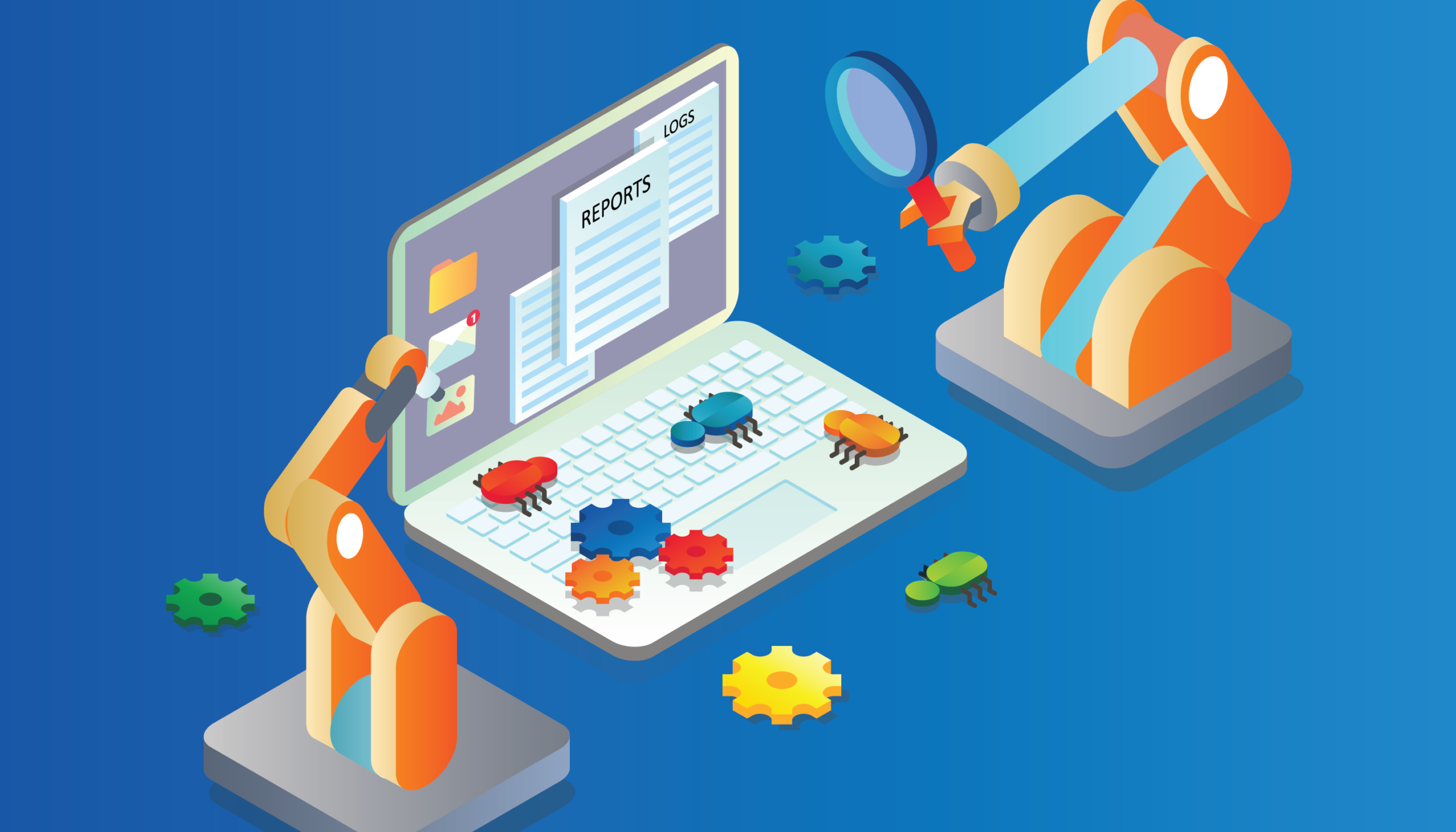
Test Automation
(8 minutes of reading time) Test automation is a software development technique that automates the execution of tests at different stages of project development. It is important to consider that the high number of steps for software development can make the process error prone. It is precisely to avoid these errors that the idea of test automation comes in. This idea helps reduce the time and effort required to test the software and improve quality. Thus, test automation has been a key tool. The importance of test automation in software development is undeniable today, however, it has been a challenge for many companies to adopt it due to its cost and time investment. The good news is that there are many tools, such as Selenium, that automate pages in web browsers, that have made test automation easier and more accessible than ever. In today's article, we are going to show you more about the main tools that help in automating tests in software development. Check out our content below and understand better about each of them. TOOLS THAT HELP IN TEST AUTOMATION Test automation is a software development process that involves using software tools and techniques to automate functional testing. The process typically includes creating a test plan, running those automated tests using scripted or recorded actions, and reporting on the results. With the continuous integration systems and tools available today, developers can run their tests automatically whenever they submit code to the version control system. Here are some of the top tools used today: SELENIUM Selenium is one of the most popular tools for test automation. It helps you write scripts to automate different types of tasks like web-based testing, functional testing, and performance testing. There are several tools that end up serving as a basis from the characteristics of Selenium, some of them are: Watir, Robot Framework and Katalon Studio. In addition, the tool is extremely flexible, being able to be used on Windows, Mac, Linux and in several Internet browsers. It is worth noting that Selenium allows developers to write automated tests in any programming language and can be used by both back-end and front-end developers. It also has several features like test suites, Selenium IDE, and Selenium Grid. RANOREX Ranorex is a leading test automation tool for software developers. It helps companies to automate their software testing process and increase their product quality. The best thing about this tool is that it can be used by anyone with no programming experience or knowledge. This tool has a wide range of features and capabilities that help automate complex testing scenarios, helping teams develop software faster and with less effort, which saves the business time and money. Some of its main functions are: GUI recognition, object map editor, recording and playback, test code that can be reused, among many other features. It is indeed a highly recommended tool. ROBOTIUM Robotium is one of the main tools for software development along with Selenium and Appium. It is a framework that allows developers to write tests in Java and other languages. It implements the popular behavior-oriented development (BDD) approach. The Robotium framework features an easy-to-use API that provides a high degree of abstraction over the underlying platform implementation, allowing it to run on Android, as well as providing an easy way to integrate with existing codebases in projects. Its lightweight design means it can be easily integrated into legacy applications without performance issues or extra maintenance costs. WATIR Watir is a free and open-source automation tool that can be used to test web applications. It is Ruby-based software that makes it easy for developers to automate the testing of their web applications. This tool can be used in many ways during software development, such as code coverage, regression testing, and functional testing. UFT — Unified Functional Testing UFT is one of the most popular commercial testing tools when it comes to functional software testing. Providing a wide range of features for API, web services and GUI testing of desktop, web, and mobile software, UFT uses Visual Basic Scripting Edition to record test and control processes. Integrated with Mercury Business Process Testing and Mercury Quality Center, UFT supports CI through the integration of specific tools such as Jenkins. APPIUM Appium is a cross-platform open-source test automation tool for native or hybrid applications, which supports both mobile simulators and real devices. Unlike Robotium, which is exclusively aimed at the Android system, Appium is also used for automating software tests on Apple's iOS platform, which makes this tool extremely attractive to developers. With Appium it is possible to perform tests regardless of the chosen programming language, since it accepts scripts in Ruby, Java, Node.js, PHP, C#, Clojure and Perl. HOW TO AUTOMATE SOFTWARE TEST ASSERTIVELY? Software testing is an iterative process that requires a lot of time and effort. It is not a task that can be completed in one go. It requires patience, perseverance, and skills to build automation scripts that handle software testing tasks efficiently. As mentioned before, there are many benefits of automating software tests assertively. The main benefit is saving time and effort and being able to easily scale the software testing process by automating it with scripts and tools. Another benefit of automating software testing is the ability to lead a more efficient and professional software testing process. Software test automation also helps to reduce human error as well as providing more information about what is being tested. HOW TO CHOOSE THE RIGHT TOOL? As the article just showed above, there are many software test automation tools available in the market. However, it is not easy to choose the right tool for your project and for your programmer's characteristics. The most important task when choosing a test automation tool is to understand what you need it for and what features you want it to have. If you know what you need and what features are important, choosing the right tool becomes easier and more straightforward. The first step would be to define your requirements for the tool you want to use. This includes things like whether it will work on multiple platforms, whether there is capability for programming languages other than Java or Python, and whether there is a requirement for integration with other systems (like build systems), for example. From there, it becomes easier to be able to identify the ideal tool to help you in the automation of tests in software development and, thus, guarantee the reduction of the probabilities of error in the project. Do you like our content? So, follow us on social media to stay on top of innovation and read our blog. Reference: https://bit.ly/3t4X9L7 https://bit.ly/3pXKPKC
Share this article on your social networks:
Rate this article:
Other articles you might be interested in reading
- All (185)
- Career (38)
- Competitions (6)
- Design (7)
- Development (112)
- Diversity and Inclusion (3)
- Events (3)
- History (15)
- Industries (6)
- Innovation (38)
- Leadership (8)
- Projects (23)
- Well being (18)

Cloud Computing and Digital Transformation and Social Impact
(5 minutes of reading)
In recent years, we have witnessed a quiet revolution that is fundamentally reshaping the way we live and work. At the center of this transformation is cloud computing, a technological innovation that transcends physical limits and opens up new horizons of possibilities. This text will talk about this subject that is transforming the IT area. Come read!...

Tech in Education
(9 minutes of reading)
In the contemporary educational landscape, technology plays an increasingly crucial role, revolutionizing not only the way students learn, but also how educators teach. As we adapt to a digitally connected world, new trends are emerging that promise to further transform the way education is designed and delivered. Come read this text to learn about the latest trends in educational technology and explore their impact on student development and the evolution of teaching. Come with us!...

Ethical Software Development
(5 minutes of reading)
Developing software is a complex activity that goes far beyond simple coding. It involves a meticulous process of planning, design, implementation, testing and maintenance to create reliable, efficient, and secure systems. However, in addition to seeking functionality and performance, developers must also carefully consider the ethical aspects of the software they are creating. In this text we will talk about ethics and responsibility when developing software. Come read!...

Balance Between Professional and Personal Growth
(6 minutes of reading)
In a world driven by the constant search for professional success, we often find ourselves immersed in our careers, forgetting the fundamental balance between professional and personal growth. As we dedicate hours to coding, solving problems, and advancing our technical skills, it's essential to remember that our journey as human beings go beyond the lines of code. Come read our text and see super cool tips on how to achieve this balance!...

How to Highlight Programming Competition Awards on your CV
(6 minutes of reading)
In a field as dynamic as software development, it is crucial to stand out from the crowd. An exceptional way to do this is through recognition and awards won in competitive programming competitions. In addition to demonstrating your superior technical skills, these awards attest to your ability to solve complex problems, collaborate as a team, and deliver exceptional results under pressure. Today we will talk about the curriculum and competitions, are you interested? Come with us!...

Open Source and Collaboration
(5 minutes of reading)
If you're ready to start exploring the world of open source, be aware that you will encounter many learning opportunities and challenges. Collaboration is at the heart of this environment, driving innovation and influencing the direction of technology. Come read our text to find out more about this subject!...

 Innovation
Innovation 

